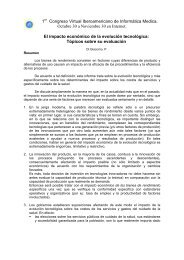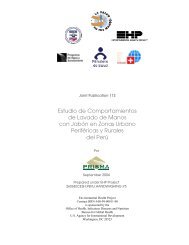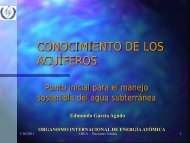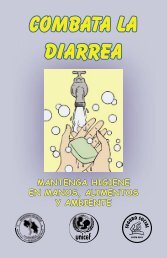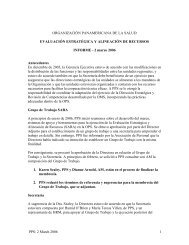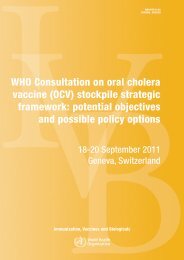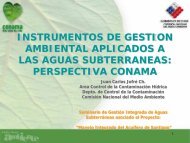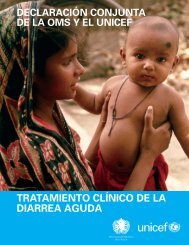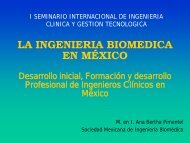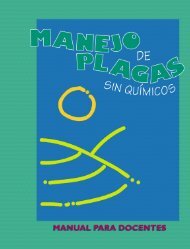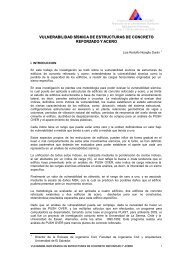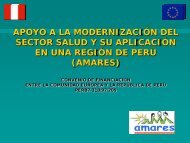a database of the National Library of M
a database of the National Library of M
a database of the National Library of M
Create successful ePaper yourself
Turn your PDF publications into a flip-book with our unique Google optimized e-Paper software.
odds ratios (& 95% confidence intervals [CI]) for plasma-positivitywere 4.11 ... in <strong>the</strong> lower-exposed workers & 6.53 ... in <strong>the</strong>higher-exposed workers, & <strong>the</strong>re was a linear trend between exposure& plasma-positivity ... . After adjusting for age & drinkingstatus, <strong>the</strong> odds ratios (& 95% CIs) were 1.64 ..., & 2.65 ...,respectively, & <strong>the</strong>re was a significant linear trend between exposure& plasma-positivity ... . In summary, Asp13-Ki-ras oncoprotein can befound in <strong>the</strong> plasma <strong>of</strong> VC workers ..., & a significant dose-responserelationship exists between plasma oncoprotein expression & VCexposure.[Luo JC et al; J Occup Environ Med 40 (12): 1053-1058(1998)]**PEER REVIEWED**Gap junctional intercellular communication is <strong>of</strong>ten impaired in cancers,& <strong>the</strong> genes which encode <strong>the</strong> connexin gap junction proteins areconsidered to be tumor-suppressor genes. In this study, we analyzed <strong>the</strong>presence <strong>of</strong> mutations in <strong>the</strong> connexin 37 (Cx37) gene in 22 human hepaticangiosarcomas, 6 & 4 <strong>of</strong> which were associated with exposure to vinylchloride & Thorotrast, respectively. The o<strong>the</strong>r 12 samples were frompatients with no history <strong>of</strong> exposure to <strong>the</strong>se 2 agents. In 9 samples, aproline (ACC) to serine (ACT) amino acid change in codon 319 was detected.However, DNA from non-tumorigenic tissue <strong>of</strong> <strong>the</strong> same patients also showedthis amino acid change, suggesting that this is a polymorphism ra<strong>the</strong>r thana mutation. Subsequent analysis <strong>of</strong> 84 DNA samples from normal donorsrevealed <strong>the</strong> frequencies <strong>of</strong> Pro/Pro, Pro/Ser & Ser/Ser alleles to be65.5%, 23.8% & 10.7%, respectively, while among <strong>the</strong> group <strong>of</strong>angiosarcoma patients <strong>the</strong> corresponding figures were 59.1%, 31.8% and 9.1%, respectively. Thus, <strong>the</strong>re was no correlation between <strong>the</strong> polymorphismat codon 319 & hepatic angiosarcoma occurrence. However, among <strong>the</strong> 6cases <strong>of</strong> vinyl chloride-associated angiosarcoma, <strong>the</strong> percentages <strong>of</strong> <strong>the</strong>polymorphic alleles were 33.3%, 66.7% & 0%, respectively. While <strong>the</strong>number <strong>of</strong> samples was too small to allow us to conclude that <strong>the</strong> Ser319allele in Cx37 predisposes to this rare type <strong>of</strong> human cancer, it may benoted that codon 319 is located at <strong>the</strong> cytoplasmic tail <strong>of</strong> Cx37, wheremost regulatory sequences reside, and that it could be a site <strong>of</strong>phosphorylation for some protein kinases, which may in turn affect <strong>the</strong>function <strong>of</strong> Cx37, including intercellular communication. [Saito T et al;Int J Cancer 86 (1): 67-70 (2000)]**PEER REVIEWED**Two human carcinogens that have been extensively studied are vinylchloride & benzene. The active metabolites used in this study arechloroacetaldehyde (CAA) & para-benzoquinone (pBQ). Each formsexocyclic adducts between <strong>the</strong> N1 & N6 <strong>of</strong> A, <strong>the</strong> N3 & N4 <strong>of</strong> C &<strong>the</strong> N1 & N2 <strong>of</strong> G. Only CAA has been found to form <strong>the</strong> N2,3 adduct <strong>of</strong>G. CAA & pBQ adducts differ structurally in size & in <strong>the</strong> number<strong>of</strong> added rings, pBQ adding 2 rings to <strong>the</strong> base, while e<strong>the</strong>no bases have asingle 5-membered ring. The mechanism <strong>of</strong> repair <strong>of</strong> <strong>the</strong>se 2 types <strong>of</strong>adducts by human enzymes has been studied in our laboratory with definedoligodeoxynucleotides & a site-specific adduct. The e<strong>the</strong>no derivativesare repaired by DNA glycosylase activity; two mammalian glycosylases areresponsible: alkylpurine-DNA-N-glycosylase (APNG) & mismatch-specificthymine-DNA glycosylase. The former repairs 1,N6-e<strong>the</strong>noA (epsilon A) asrapidly as <strong>the</strong> original substrate, 3-methyladenine, while <strong>the</strong> latterrepairs 3,N4-e<strong>the</strong>noC (epsilon C) more efficiently than <strong>the</strong> G/T mismatch.Our finding that <strong>the</strong>re are separate enzymes for epsilon A & epsilon Chas been confirmed by <strong>the</strong> use <strong>of</strong> tissue extracts from an APNG knockoutmouse. ... Fur<strong>the</strong>rmore, <strong>the</strong> pBQ adduct-containing oligomers are cleaved,to various extents by a different class <strong>of</strong> enzyme: human & bacterial



